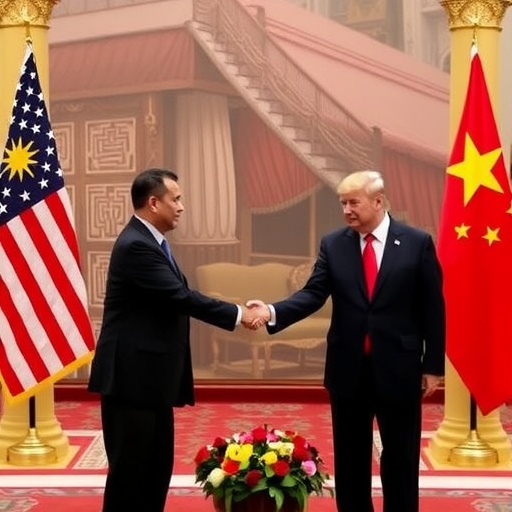US-China trade Talks Launch in Malaysia: Trump Seeks Tariff Relief Amid High-Stakes Negotiations
In a pivotal moment for global economics, US Treasury Secretary Scott Bessent and Chinese Vice Premier He Lifeng kicked off high-level US-China trade negotiations in Kuala Lumpur, Malaysia, on Saturday morning. The talks aim to pave the way for an upcoming summit between President Donald Trump and Chinese President Xi Jinping, with Trump signaling openness to tariff reductions on the staggering 157% duties currently imposed on Chinese goods. This development comes as both superpowers grapple with escalating trade tensions that have rippled through supply chains worldwide.
The choice of Malaysia as a neutral venue underscores the delicate diplomacy at play, offering a fresh start away from the acrimony of previous encounters. Sources close to the negotiations reveal that initial discussions focused on mutual concessions, with the US pushing for intellectual property protections and market access reforms, while China seeks relief from the punitive tariffs that have hampered its export-driven economy.
Scott Bessent Leads US Delegation in Push for Balanced Deal
Scott Bessent, a seasoned financier turned Treasury Secretary under Trump, arrived in Malaysia with a clear mandate: to broker a framework that eases the burden of tariffs without compromising American interests. Bessent, known for his Wall Street acumen, emphasized in a pre-talks briefing that “these trade negotiations represent a real opportunity for both nations to reset and rebuild trust.” His role is crucial, as he bridges the gap between Trump’s aggressive trade rhetoric and the need for pragmatic diplomacy.
The US delegation includes top advisors from the Office of the US Trade Representative and economic experts who have been poring over data on the US-China trade deficit, which stood at $367 billion in the previous fiscal year. Bessent’s strategy reportedly involves phased tariff reductions tied to verifiable Chinese commitments on subsidies for state-owned enterprises and technology transfers. In a recent interview with Bloomberg, Bessent stated, “We’re not here to dictate terms, but to demand fairness—tariffs have been a wake-up call, and now it’s time for action.”
On the Chinese side, Vice Premier He Lifeng, a key architect of Beijing’s economic policies, brings a wealth of experience from steering China’s response to previous trade spats. He Lifeng’s team is said to be prepared with proposals for increased purchases of US agricultural products and energy exports, aiming to address Trump’s long-standing grievances over trade imbalances. The vice premier’s opening remarks highlighted China’s willingness to engage, noting that “cooperation benefits all, while confrontation harms everyone.”
Trump’s Vision: Tariff Cuts as Leverage for Broader Reforms
President Trump has been vocal about his desire for a “big, beautiful deal” in US-China trade, tweeting just days before the talks that “China knows the tariffs hurt—time for them to come to the table with real concessions!” The 157% tariff rate, a culmination of multiple rounds imposed since 2018, has targeted everything from electronics to apparel, costing US importers an estimated $80 billion annually in additional duties, according to the Peterson Institute for International Economics.
Trump’s approach blends carrot and stick: while hinting at relief, he has warned of further escalations if progress stalls. In a Fox News appearance, Trump elaborated, “I’ve always said tariffs are the most beautiful word in the dictionary for negotiation. But we’re ready to lower them if Xi meets us halfway on IP theft and forced tech transfers.” This stance reflects Trump’s broader economic nationalism, which prioritizes reshoring manufacturing and reducing reliance on Chinese supply chains—a theme echoed in his recent executive orders promoting domestic semiconductor production.
Economists point out that the tariffs have already reshaped global trade patterns. For instance, Vietnam and Mexico have seen surges in exports to the US, with Vietnam’s trade surplus jumping 25% year-over-year. However, critics argue that American consumers bear the brunt, with studies from the National Bureau of Economic Research showing a 0.4% drop in US household purchasing power due to higher prices on imported goods.
Echoes of Past Tensions: From Phase One to Fresh Impasse
The current trade negotiations build on the fragile Phase One agreement signed in 2020, which promised $200 billion in additional Chinese purchases of US goods but fell short by about 40%, per US government assessments. That deal temporarily halted tariff escalations but left core issues like subsidies and market barriers unresolved, leading to renewed frictions under the Biden administration before Trump’s return.
Since Trump’s reelection, rhetoric has intensified. In December, the US announced probes into Chinese electric vehicle subsidies, prompting Beijing to retaliate with restrictions on rare earth exports—critical minerals that power everything from smartphones to fighter jets. Global markets reacted swiftly; the Dow Jones dipped 2% following the news, while Shanghai’s Composite Index fluctuated amid uncertainty.
Historical data underscores the stakes: bilateral trade volume hit $690 billion in 2023, but tariffs have diverted $100 billion in flows elsewhere, benefiting competitors like India and the EU. A report from the World Trade Organization warns that prolonged stalemate could shave 1.5% off global GDP growth by 2025. Participants in the Malaysia talks are drawing lessons from past failures, with informal side meetings scheduled to foster rapport between negotiators.
One anonymous US official described the atmosphere as “cautiously optimistic,” adding that cultural exchanges, including a joint dinner featuring Malaysian cuisine, are designed to humanize the process. China’s state media, Xinhua, reported that He Lifeng stressed “win-win outcomes,” signaling Beijing’s intent to avoid a repeat of the 2019 trade war’s economic drag, which slowed China’s growth to 6%—its lowest in decades.
Global Ripples: How Tariff Relief Could Reshape Economies
Beyond the bilateral stakes, these trade negotiations hold implications for the world economy. A successful deal could stabilize commodity prices, boost investor confidence, and ease inflationary pressures that have lingered post-pandemic. For example, lower tariffs on Chinese steel and aluminum—currently at 25% and 10% respectively—might reduce costs for US automakers, potentially lowering car prices by 5-7%, according to analysts at Goldman Sachs.
However, challenges abound. Environmental groups worry that easing tariffs without green tech standards could undermine global climate goals, given China’s dominance in solar panel production. Labor unions in the US, represented by the AFL-CIO, have urged Bessent to tie any relief to stronger worker protections against offshoring.
Market watchers are eyeing sectors like tech and agriculture. Apple’s supply chain, heavily reliant on Chinese assembly, could see relief if tariffs on components drop, while soybean farmers in the Midwest—hit hard by past retaliations—anticipate renewed demand. A Moody’s Analytics forecast suggests a 10% tariff reduction could add $50 billion to US GDP over two years, though much depends on enforcement mechanisms.
Internationally, allies like Japan and the EU are monitoring closely. The EU, facing its own tariff battles with China over EVs, has expressed support for coordinated action. In a statement, EU Trade Commissioner Valdis Dombrovskis said, “Multilateral cooperation is key to addressing imbalances— we stand ready to align with US efforts.”
Path to the Trump-Xi Summit: Milestones and Uncertainties Ahead
As the Malaysia talks progress into their second day, all eyes are on deliverables that could set the agenda for the Trump-Xi summit slated for early next year, possibly in Singapore or Hawaii. Negotiators aim to outline a roadmap by Sunday evening, including working groups on digital trade and supply chain resilience.
Trump has teased the possibility of a “historic agreement” that could include tariff rollbacks to pre-2018 levels in exchange for Chinese investments in US infrastructure. Yet, hurdles remain: domestic politics in both countries complicate concessions. In the US, hawkish Republicans demand ironclad guarantees, while in China, nationalist sentiments resist perceived capitulation.
Looking forward, experts predict incremental progress rather than a grand bargain. The Carnegie Endowment for International Peace outlines three scenarios: a modest deal averting escalation (most likely, 60% probability), stalled talks leading to new tariffs (30%), or breakthrough reforms (10%). Regardless, the outcome will influence everything from stock markets to geopolitical alliances.
For businesses, the advice is clear: diversify and prepare. As one supply chain consultant told Reuters, “These negotiations could unlock billions, but uncertainty means hedging bets is essential.” With the global economy at a crossroads, the Malaysia dialogue represents not just economic maneuvering, but a test of whether the world’s two largest economies can collaborate amid rivalry.









